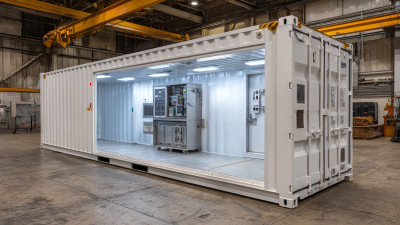Transforming Lives: How Freight Container Homes Can Reduce Housing Costs by 30% in Urban Areas
As urban areas continue to grow and housing prices soar, innovative solutions are urgently needed to address the pressing issue of affordable living. Enter freight container homes, a groundbreaking concept that transforms surplus shipping containers into modern, livable spaces. Not only do these homes offer a sustainable alternative to traditional housing, but they also have the potential to reduce housing costs by an impressive 30%. This cost-effectiveness is particularly vital in densely populated cities where the demand for affordable housing is at an all-time high.

By repurposing freight containers, we can create efficient, eco-friendly homes that meet the needs of urban dwellers while minimizing environmental impact. This article explores the transformative potential of freight container homes and how they can revolutionize urban living by making housing more accessible to everyone.
Innovative Design Approaches for Freight Container Homes in Urban Settings
The innovative design approaches for freight container homes in urban settings are reshaping the landscape of affordable housing. By repurposing shipping containers, architects and builders are able to create stylish, functional living spaces that challenge traditional construction methods. These homes often utilize modular designs, allowing for customization and scalability, making them particularly appealing in densely populated cities. Features such as green roofs, large windows for natural light, and integrated storage solutions enhance both aesthetics and utility, transforming how we perceive container living.
Moreover, the sustainability aspect of freight container homes cannot be overlooked. By utilizing pre-existing materials, these designs significantly reduce the carbon footprint associated with new construction. Urban areas can benefit from efficient layouts that maximize available space, integrating outdoor areas and communal facilities that foster a sense of community. This innovative approach not only addresses the pressing issue of housing affordability but also promotes eco-friendly living, proving that design can play a pivotal role in solving urban housing challenges.

Cost-Benefit Analysis: Comparing Freight Container Homes to Traditional Housing
As urban areas continue to grapple with soaring housing costs, freight container homes are emerging as a viable solution that could reduce expenses by up to 30%. A recent market analysis predicts the container-based housing market will surge from USD 60.02 billion in 2024 to an estimated USD 95.74 billion by 2033, reflecting a robust compound annual growth rate (CAGR) driven by demand for affordable living spaces. This trend is particularly vital in cities like Chicago, where innovative shipping container projects are reshaping urban landscapes, catering not only to housing but also to unique retail spaces and sustainable community developments.
The benefits of container homes extend beyond their initial cost savings. Research indicates that using shipping containers for building can significantly cut construction timelines, allowing for quicker returns on investment compared to traditional housing methods. For instance, communities have begun using this approach to alleviate student housing shortages in Europe, which last year faced a deficit of 3 million beds. By repurposing containers, these projects demonstrate that effective solutions can be crafted from previously underutilized resources, reflecting a broader shift toward sustainable and economical living arrangements in densely populated areas.
Transforming Lives: How Freight Container Homes Can Reduce Housing Costs by 30% in Urban Areas - Cost-Benefit Analysis: Comparing Freight Container Homes to Traditional Housing
| Housing Type | Average Construction Cost (per square foot) | Average Size (square feet) | Total Construction Cost | Monthly Maintenance Cost | Estimated Lifespan (Years) |
|---|---|---|---|---|---|
| Freight Container Home | $150 | 320 | $48,000 | $200 | 25 |
| Traditional Home | $215 | 1,500 | $322,500 | $350 | 50 |
Sustainability and Eco-Friendliness of Freight Container Homes
Freight container homes have gained popularity as a trendy and innovative housing solution that promises sustainability. However, the reality of their environmental impact is nuanced. While they are often marketed as eco-friendly, some experts argue that shipping containers may not be as green as they appear. Factors such as the energy-intensive processes involved in manufacturing and transporting these containers, along with their potential chemical treatments, raise questions about their overall sustainability.
Innovative approaches are emerging to enhance the eco-friendliness of container homes. Projects like solar-powered container homes made from repurposed materials showcase how sustainability can be integrated into such designs. These efforts illustrate the potential of shipping containers to provide affordable housing while maintaining a smaller ecological footprint. By utilizing durable materials and focusing on energy-efficient solutions, container homes can indeed contribute to an environmentally conscious housing ecosystem, potentially making a significant impact on urban areas facing housing shortages.
Urban Zoning Laws: Navigating Regulations for Container Home Developments
Container homes present a transformative opportunity in addressing urban housing shortages, but navigating urban zoning laws is essential for successful development. According to the U.S. Department of Housing and Urban Development, the average cost of constructing new homes has increased by 25% over the last decade, pushing many potential homeowners toward alternative housing solutions. Freight container homes can significantly reduce overall housing costs by up to 30%, making them an appealing option for urban dwellers. However, these innovative structures often face regulatory challenges that agents and developers must carefully consider.
To build container homes, it’s essential to understand local zoning regulations that dictate land use, building height, and design standards. A report from the National Association of Home Builders highlights that nearly 60% of American cities have zoning laws that can hinder the deployment of alternative housing types, including container housing. Developers must navigate these regulations collaboratively with city planners to create a feasible framework for container home developments. By leveraging community engagement and understanding the nuances of local laws, it’s possible to unlock the potential of freight container homes as an affordable housing solution in urban areas.

Case Studies of Successful Freight Container Home Projects Across Major Cities
Freight container homes have emerged as a viable solution to the escalating housing crisis in urban areas, with several successful projects illustrating their potential. Cities like Amsterdam and Los Angeles have pioneered the use of shipping containers to create affordable housing. In Amsterdam, an innovative project transformed a disused shipping yard into a vibrant community of container homes. This initiative not only provided housing for low-income families but also revitalized the area, turning it into a desirable neighborhood.
Similarly, in Los Angeles, a cluster of container homes was developed to address homelessness. The project demonstrated a quick and cost-effective method of building sustainable shelters. By leveraging repurposed freight containers, developers were able to significantly reduce construction costs and timelines—achieving an estimated 30% savings compared to traditional housing methods. These case studies highlight how freight container homes can play a crucial role in rethinking urban living while offering a practical alternative to rising housing costs.
Transforming Lives: The Impact of Freight Container Homes on Housing Costs
This chart illustrates the percentage of housing cost reduction achieved through the implementation of freight container homes in various urban areas, showcasing successful case studies.
Related Posts
-

Innovative Cargo Container Buildings Transforming Urban Living Spaces
-

Innovative Design Ideas for Sustainable Living with Freight Container Homes
-

Unlocking the Potential of Custom Built Shipping Containers for Sustainable Living Solutions
-

Revolutionizing Modern Architecture: The Rise of Cargo Container Construction in Sustainable Living
-

Transforming Spaces: The Versatile Benefits of Custom Built Shipping Containers in Modern Architecture
-

Unlocking the Potential: Innovative Uses for Specialty Shipping Containers in Modern Industries

